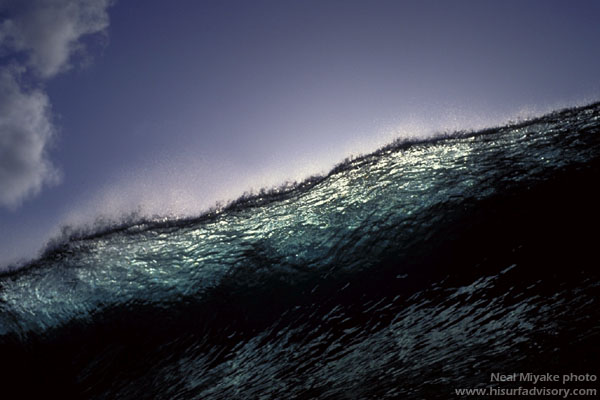|
I get lots of email inquiries on surf photography. Here are some basics that I've learned through research and experience. Hope this helps you nail that killer shot. Water Photography Tips On everyday sessions, I use a disposable camera attached to a lanyard that I tuck behind my neck in my rash guard. This keeps the camera tight and out of the way, but still easily accessible. I just pop it out, shoot, and tuck it back. When the surf is really good and really crowded, I sometimes use my Nikonos waterproof camera, usually dispensing with a board. Before going into the water, check the camera for possible leaks or compromises. Putting something on the lens helps sheet the water to avoid droplets--I use saliva. I've never tried those antifogging waxes-don't like the idea of having something greasy on the lens. Of course, use swimfins (I use Vipers). For added psychological support, I also use paddling gloves (by H2Odyssea)--a bit cumbersome to handle the camera, but a good trade for extra arm power. Get as close to the action as possible. This cannot be understated. Of course, this is a product of the lens you are using, but the closer the better. Focusing is a challenge. I prefocus my Nikonos, estimating how far the subject will be when I shoot. That takes anticipation. Other important elements are adequate lighting (bright sunlight the best) and keeping the camera stable and still while snapping the shot. Both make a huge difference when getting the results. Having a good rapport with the person you are shooting is a plus, but an understanding of the break is even more important. Need to know where the wave will pitch or bowl so you can be right inside of the action. Control how fast you shoot. Reloading takes time. But then again, sometimes you gotta just go for it. Land Shot Tips Typically you have to shoot from faraway, so use as much telephoto as you can get. Good to get at least 400-600 mm for 35 mm lenses. Always use a tripod. Land Videography Tips I admittedly am not very adept at shooting video. Just haven't had the time or inclination to do it. However, I do have some general tips that may be of interest. First off, as an amateur videographer I would strongly recommend using Mini-DV. The technology is very mature and widespread now. Cameras and videotape have become relatively inexpensive, and the size is incredibly small. When shooting from the shore, try to use a tripod. Handholding those cameras are difficult. Interestingly, the smaller cameras may be harder to use because they are so light--if you aren't using a tripod, make sure you use both hands to stabilize the camera. Don't zoom in and out too much or too quickly (I'm guilty of this cardinal sin). The end product comes out really annoying. Try to do it smoothly, or don't do it at all. I personally don't care for digital zoom, although some people use it with no problem. Best to get a camera with a big optical zoom ratio. Digital Photography Digital cameras are a new realm that offer lots of different options, but there are drawbacks. With digital, you can shoot to your heart's content, keeping only the shots that you like. You can also preview your shots right on the spot. However, although the quality is getting better, the resolution cannot compare to good slide film. Depending on how you will be using the photo, this might not matter. A couple maddening thing about most digital cameras is that they take a long time to lock in exposure and focus, and there usually is a long refresh time between shots as the camera saves an image. For action sports photography, this really hampers your shooting. Also, most digital cameras have woefully inadequate optical zoom (digital zoom interpolates pixels so you aren't really getting better detail). Of course, you may not need a big zoom. Film tips (35 mm) As a general rule, Kodak film seems like a warmer film, with strong reds and oranges. Fuji film typically have stronger blues and greens. For Hawaii conditions, I prefer Fuji. Print film is less sensitive to exposure-related problems, but do not have the grain quality. Slide film is much richer. Print is usually cheaper. As for film, well that's a whole story in itself. For slides, I prefer Fuji Sensia because you can get it with ASA 400. The Provias and Velvias are too expensive and I can't handle the slow speed and short expiration period. For print film, I used to use exclusively Fuji because of the nice blues and greens exposure. However, I've recently tried the Kodak Max films and love the quality. Haven't had the chance to try the Fujifilm Superia equivalent. The best source of info that I've found on surf photography is this 1999 article from Surfer Magazine Exposure: My rule of thumb was taught to me by Bernie Baker. At 1/500 second in bright sunlight using ASA 100 film, shoot at F8. Adjust either of the three for changes accordingly. Has worked really well. Heard that a wave's whitewater explosion can give false automatic exposure readings, so manually setting the exposure might be a better deal. Focus I don't have a DIGITAL PHOTO EDITING
|
